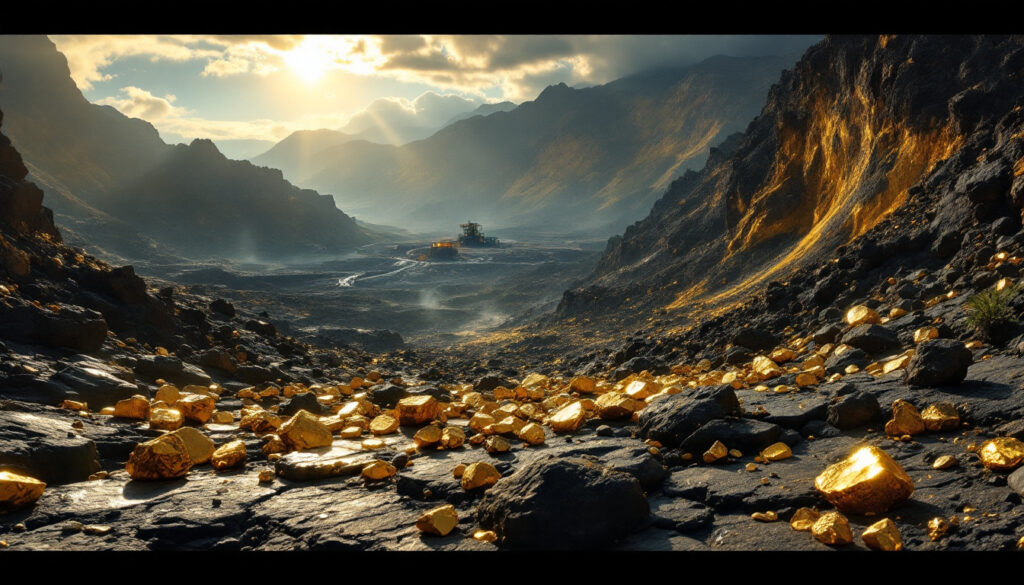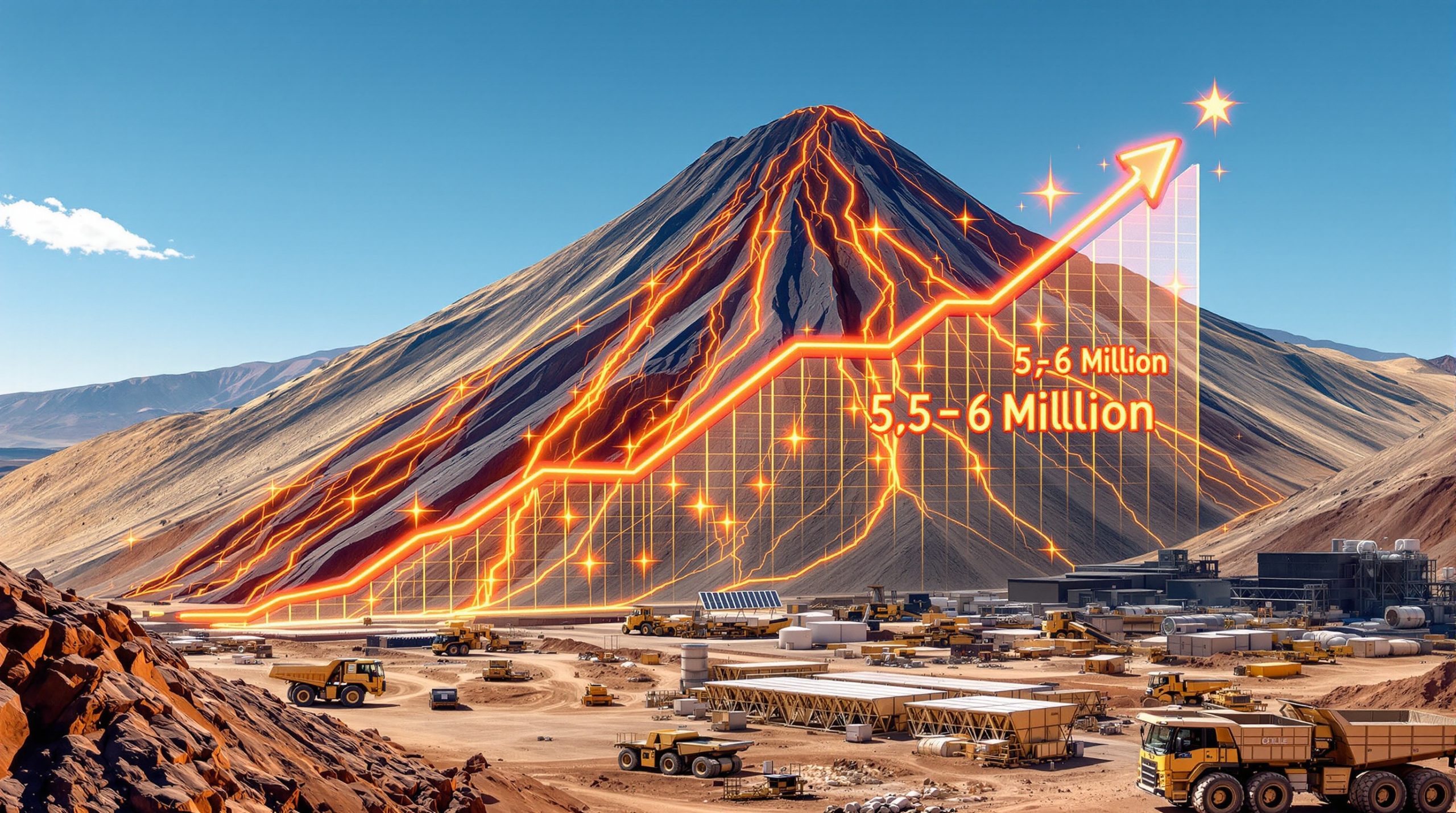Unlocking Potential: Askari's Strategic Gold Acquisition in the Ethiopian Greenstone Belt
The mining world is turning its attention to East Africa as Askari Metals (ASX:AS2) strategically positions itself in one of Africa's most promising yet underexplored gold regions. Through its acquisition of a significant project portfolio in Ethiopia's Adola Greenstone Belt, the company is making a calculated entry into a historically productive gold region with substantial untapped potential.
The Adola Greenstone Belt: Ethiopia's Golden Frontier
Located within the prolific Arabian-Nubian Shield, Askari's newly acquired 460 square kilometer land package represents a significant foothold in a region with proven gold-producing capabilities. This geological formation spans multiple countries across Northeast Africa and the Arabian Peninsula and has demonstrated remarkable potential for precious metals deposits.
The belt's geological significance cannot be overstated. Home to Ethiopia's only modern gold mines—Sakaro and Lega Dembi—the region has already yielded more than 3 million ounces of gold through historical production. These established operations demonstrate the belt's capacity for hosting large-scale, economically viable gold deposits.
"The Adola Greenstone Belt represents one of the last mineral-rich frontier belts offering significant exploration upside with multi-million-ounce potential," notes Executive Director Gino D'Anna, highlighting the strategic importance of this acquisition.
What makes this acquisition particularly compelling is its strategic positioning along strike from these proven gold mines, providing Askari with geological confidence and operational insights that could accelerate exploration success.
Strategic Positioning Through the Rift Valley Metals Acquisition
Askari's entry into the Ethiopian gold sector comes through a binding Share Purchase Agreement for all issued capital of Rift Valley Metals Pty Ltd. This transaction represents one of the first major Australian mining investments in this specific region, giving Askari first-mover advantage in an underexplored section of a proven gold belt.
The market has responded positively to this strategic move, with Askari shares climbing 11.11% to trade at 1 cent following the announcement on April 30, 2025. This increase reflects growing investor interest in the company's pivot into Ethiopian gold exploration and signals potential for revaluation as exploration progresses.
The 460 square kilometer land package sits within the same geological setting that hosts multi-million-ounce deposits, positioning Askari to potentially replicate the success of established operations nearby.
Why the Arabian-Nubian Shield Matters to Gold Explorers
Geological Characteristics That Drive Major Discoveries
The Arabian-Nubian Shield represents one of geology's most promising yet underutilized treasure troves for precious metals. Formed during the assembly of the supercontinent Gondwana, this ancient geological shield spans Northeast Africa and the Arabian Peninsula, creating ideal conditions for gold mineralization.
The shield is characterized by greenstone belts—geological formations known worldwide as prime hosts for gold deposits. These belts contain diverse mineral potential beyond gold, including copper and other base metals, offering explorers multiple commodity opportunities within a single geological province.
What makes the Arabian-Nubian Shield particularly attractive to miners and investors alike is its geological similarity to other highly productive gold regions worldwide, yet with significantly less exploration history. While comparable greenstone belts in Australia, Canada, and West Africa have been extensively explored and developed, large portions of the Arabian-Nubian Shield remain virtually untouched by modern gold mining innovations.
Regional Success Stories Validating Exploration Potential
The shield's gold potential isn't merely theoretical—it's been proven through multiple significant discoveries across Egypt, Sudan, Eritrea, Ethiopia, Saudi Arabia, and Yemen. These discoveries demonstrate the region's capacity to host world-class deposits capable of supporting major mining operations.
Notable examples include Sudan's Hassai Mine with resources exceeding 5 million ounces and Saudi Arabia's Ad Duwayhi Mine with approximately 2 million ounces. These operations serve as compelling proof-of-concept for explorers like Askari seeking similar success in geologically related areas.
Within Ethiopia specifically, the Sakaro and Lega Dembi mines have produced over 3 million ounces combined, demonstrating the country's proven capacity for hosting significant gold deposits. These mines have established both the geological potential of the region and the operational feasibility of mining in Ethiopia.
"The shield has produced discoveries in the multi-million-ounce range globally," explains Gino D'Anna, underscoring the regional potential Askari aims to tap into with its strategic land position.
How This Acquisition Transforms Askari's Growth Trajectory
Portfolio Diversification and Strategic Enhancement
This Ethiopian acquisition represents a transformative move for Askari Metals, significantly diversifying its exploration portfolio while creating a focused gold development opportunity. By securing this substantial land package within a proven gold belt, Askari positions itself as a potentially significant player in Ethiopian mineral exploration.
The acquisition complements Askari's existing exploration assets while expanding its commodity exposure and geographical presence. This diversification helps mitigate risk while creating multiple pathways to discovery and shareholder value creation.
Perhaps most importantly, the acquisition provides Askari with a first-mover advantage in a region that remains underexplored despite proven geological potential. This early positioning could allow the company to establish a dominant land position before competition intensifies, providing strategic advantages in resource development and regional knowledge.
Executive Vision and Development Roadmap
"This acquisition positions Askari with a significant first-mover advantage," states Executive Director Gino D'Anna, highlighting the strategic importance of early entry into this promising gold region.
The company's vision extends beyond mere land acquisition to systematic exploration and potential resource development. Askari plans to implement a methodical approach to evaluating the 460 square kilometer land package, focusing initially on areas with geological similarities to the nearby Sakaro and Lega Dembi gold mines.
This approach will likely involve:
- Initial reconnaissance and mapping to identify priority target areas
- Geophysical surveys to define subsurface structures that might host mineralization
- Systematic soil and rock sampling to identify surface expressions of potential deposits
- Targeted drilling to test the most promising anomalies
By applying modern exploration techniques to this relatively underexplored terrain, Askari aims to unlock value that previous, less sophisticated exploration efforts may have missed.
Technical Factors Making This Project Compelling
Geological Similarities to Proven Gold-Producing Areas
The technical case for Askari's Ethiopian project rests primarily on its geological setting within the Adola Greenstone Belt. This geological formation shares key characteristics with other highly productive gold regions worldwide, including:
- Similar stratigraphic sequences featuring mafic volcanic rocks interlayered with sedimentary units
- Comparable structural complexity with multiple phases of deformation
- Presence of major shear zones that can act as conduits for mineralizing fluids
- Evidence of hydrothermal alteration associated with gold mineralization
The project's proximity to the Sakaro and Lega Dembi mines—less than 50 kilometers away—provides additional technical confidence. These established operations demonstrate not only the presence of gold in the region but also its concentration in economically viable deposits.
"The assets are strategically located along strike of large-scale mines," notes Gino D'Anna, highlighting the geological connection between Askari's ground and proven production areas.
Exploration Upside and Resource Potential
Technical assessment of the property suggests potential for both near-surface and deeper gold mineralization. This dual potential creates multiple exploration targets, from easier-to-develop oxide resources near surface to potentially larger sulfide resources at depth.
Lega Dembi's average grade of approximately 3.5 g/t Au provides a regional benchmark that suggests the potential for high-grade mineralization within Askari's project area. This grade profile would support economic extraction even in a remote setting with higher operational costs.
The exploration strategy will likely involve:
- Advanced geophysical techniques to identify structural controls
- Detailed geochemical sampling to define anomalous zones
- Systematic drilling to test target concepts
- Metallurgical testing to determine processing characteristics
Modern exploration technologies—from drone-based magnetic surveys to portable XRF analyzers—allow Askari to explore more efficiently than historical efforts in the region. These technological advantages could accelerate the path from acquisition to discovery.
Challenges and Opportunities in Ethiopian Mining
Navigating an Emerging Mining Jurisdiction
While Ethiopia offers significant geological potential, operating in an emerging mining jurisdiction presents both challenges and opportunities. Ethiopia's mining sector remains relatively underdeveloped, with mining contributing less than 5% to the country's GDP as of 2025 estimates.
Infrastructure development represents one of the primary operational considerations. Remote areas of the Adola Belt may have limited road access, power availability, and water resources, necessitating investment in basic infrastructure to support exploration activities. However, this challenge also represents an opportunity to develop purpose-built facilities optimized for modern mining operations.
The regulatory environment in Ethiopia continues to evolve, with the 2023 Mining Proclamation designed to attract foreign investment through tax incentives and clearer permitting processes. Understanding and navigating these regulations will be critical to Askari's success.
"Building local relationships and understanding regulatory frameworks is critical," emphasizes Gino D'Anna, acknowledging the importance of social license to operate in any mining jurisdiction.
Ethiopia's Position in the Global Mining Landscape
Ethiopia's mining sector stands at an inflection point. Historically underexplored compared to more established African mining nations like Ghana, Tanzania, and South Africa, Ethiopia nevertheless possesses significant geological potential that is increasingly attracting international attention.
Government initiatives to attract mining investment have accelerated in recent years, with policy reforms designed to create a more predictable operating environment. These changes position Ethiopia as an increasingly attractive destination for mining investment guide seekers, particularly for companies willing to accept the higher risk profile of frontier markets in exchange for higher potential returns.
KEFI Minerals' Tulu Kapi project provides a useful model for community engagement in the Ethiopian context, demonstrating both the challenges and potential solutions for developing mining projects in the country. Askari can learn from these experiences to optimize its approach to stakeholder engagement.
As Ethiopia continues to develop its mining sector, companies with early positions in proven geological terrains stand to benefit from both resource potential and evolving infrastructure improvements. This combination of geological promise and improving investment conditions creates a compelling opportunity for companies like Askari with the technical capability to identify and develop mineral resources in emerging regions.
How This Project Compares to Other Gold Exploration Opportunities
Comparative Analysis with Global Greenstone Belt Projects
When evaluating Askari's Ethiopian gold project against other exploration opportunities globally, several factors merit consideration:
-
Geological Potential: The Arabian-Nubian Shield compares favorably to other major greenstone belts like Australia's Eastern Goldfields, Canada's Abitibi, and West Africa's Birimian Belt. All have produced multiple multi-million-ounce deposits.
-
Exploration Maturity: Unlike these more mature districts, the Adola Greenstone Belt remains significantly underexplored using modern techniques, potentially offering greater discovery potential at lower acquisition costs.
-
Competitive Landscape: The Ethiopian mining sector features fewer major competitors than established gold regions like Western Australia or Ontario, potentially allowing junior explorers like Askari to secure larger, more prospective land positions.
-
Risk-Reward Profile: While operational risks in Ethiopia exceed those in established mining jurisdictions, the potential reward—discovering a significant deposit in an underexplored belt—creates a compelling risk-adjusted opportunity.
This comparative assessment suggests that while Askari's Ethiopian project carries higher jurisdictional risk than exploration in established mining countries, it also offers potentially higher rewards through the opportunity to make significant discoveries in relatively untested ground.
Investment Considerations for Gold Exploration in Ethiopia
Investors evaluating Askari's Ethiopian project should consider several key performance indicators as exploration progresses:
-
Early Exploration Results: Initial reconnaissance sampling, geophysical surveys, and preliminary drilling results will provide the first indicators of mineralization potential.
-
Resource Definition Timeline: Progression from initial discovery to resource definition typically requires 12-24 months of systematic exploration, with maiden resource estimates representing significant valuation catalysts.
-
Capital Requirements: Exploration programs in remote regions typically require higher capital intensity than projects with better infrastructure access, necessitating strategic capital allocation.
-
Regulatory Milestones: Securing and maintaining exploration permits, environmental approvals, and community agreements represent critical path items for project advancement.
Potential catalysts for company revaluation include positive initial exploration results, maiden resource announcements, metallurgical test results confirming processing viability, and advancement through key regulatory milestones. Each of these developments could drive significant share price appreciation as the project de-risks.
FAQ: Askari's Ethiopian Gold Project
What is a greenstone belt and why is it significant for gold exploration?
Greenstone belts are ancient volcanic-sedimentary rock formations that have undergone metamorphism, creating ideal conditions for gold mineralization. They represent some of Earth's oldest rock formations, dating back 2.5-3.8 billion years to the Archean and Proterozoic eras.
These geological formations are significant for gold exploration because they host many of the world's largest and highest-grade gold deposits. The complex geological history of greenstone belts—involving multiple phases of magmatism, sedimentation, deformation, and fluid movement—creates numerous opportunities for gold concentration.
The Adola Greenstone Belt specifically shows many characteristics common to productive gold regions worldwide, including:
- Complex structural controls that create pathways for mineralizing fluids
- Favorable host rocks that react chemically with these fluids to precipitate gold
- Evidence of multiple mineralizing events that can create enriched deposits
Statistical analysis shows that greenstone belts host approximately 75% of the world's gold resources above 1 million ounces, making them prime exploration targets despite often challenging exploration conditions.
How does Ethiopia compare to other African gold-producing nations?
Ethiopia currently ranks as a relatively minor gold producer compared to established African mining countries, but its geological potential suggests significant room for growth:
| Country | Annual Gold Production (tonnes) | Major Mining Companies | Exploration Maturity |
|---|---|---|---|
| Ghana | 130 | Newmont, AngloGold, Kinross | Mature |
| South Africa | 120 | Harmony, Gold Fields, AngloGold | Mature |
| Sudan | 90 | Managem, La Mancha | Developing |
| Mali | 60 | B2Gold, Barrick | Intermediate |
| Burkina Faso | 55 | Endeavour, IAMGOLD | Intermediate |
| Ethiopia | 15 | MIDROC | Early-stage |
While Ethiopia's current production lags behind leaders like Ghana and South Africa, its geological setting in the Arabian-Nubian Shield suggests potential comparable to Sudan, which has seen rapid production growth in recent years.
Ethiopia's regulatory environment has evolved more slowly than some other African mining jurisdictions, but recent reforms signal increasing government interest in developing the sector. Infrastructure remains less developed than in West African gold regions, particularly regarding power generation and transportation networks.
What timeline might investors expect for exploration results?
Exploration programs in greenstone belts typically progress through several phases, each with distinct timelines:
-
Initial Reconnaissance (3-6 months):
- Geophysical surveys and surface sampling
- Target generation and prioritization
- Preliminary geological modeling
-
Target Testing (6-12 months):
- First-pass drilling of priority targets
- Initial assay results to confirm mineralization
- Refinement of geological model
-
Resource Definition (12-24 months):
- Systematic drilling to define resource boundaries
- Metallurgical testing to determine recovery rates
- Maiden resource estimation
-
Economic Assessment (18-36 months):
- Preliminary economic assessment
- Engineering studies and mine planning
- Environmental baseline studies
First meaningful results from Askari's Ethiopian project could emerge within 6-12 months, with more comprehensive understanding developing over 2-3 years of systematic exploration. Regulatory approvals in Ethiopia typically require 3-6 months for exploration permits and 12-18 months for mining licenses, potentially impacting overall development timelines.
What factors will determine the success of Askari's Ethiopian gold project?
Several critical success factors will influence Askari's exploration outcomes:
-
Geological Prospectivity: The fundamental presence of gold mineralization in economically viable concentrations represents the most basic success criterion.
-
Exploration Effectiveness: The ability to efficiently identify and test the most promising targets through appropriate technical methods and skilled geological interpretation.
-
Operational Efficiency: Maximizing exploration value from available capital through cost-effective program design and execution.
-
Regulatory Navigation: Successfully securing and maintaining necessary permits while building productive relationships with government authorities.
-
Community Relations: Establishing and maintaining social license to operate through transparent engagement with local communities.
-
Capital Access: Securing sufficient funding to advance exploration through critical phases without excessive dilution.
-
Management Expertise: Leadership with specific experience in developing projects in emerging mining jurisdictions and greenstone belt settings.
Projects that excel across these dimensions typically progress more rapidly from exploration to development, while deficiencies in any area can create significant obstacles to advancement.
Exploration Strategy and Next Steps
Systematic Approach to Unlocking Value
Askari's exploration strategy for its Ethiopian gold project will likely follow a systematic approach designed to efficiently identify and evaluate the most prospective portions of its 460 square kilometer land package. This methodical progression helps maximize the probability of discovery while
Ready to Identify the Next Major Mineral Discovery?
Stay ahead of the market with Discovery Alert's proprietary Discovery IQ model, which instantly notifies investors of significant ASX mineral discoveries and transforms complex data into actionable insights. Explore why historic discoveries can generate substantial returns by visiting Discovery Alert's dedicated discoveries page and begin your 30-day free trial today.




